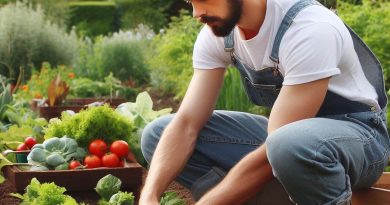Rainwater Harvest: A Boon for Urban Gardeners
Last Updated on March 2, 2024
Introduction
Urban gardeners face unique water challenges.
Municipal restrictions and small plots with poor drainage often make watering difficult.
Harvesting rain can provide a sustainable irrigation solution.
Capturing and storing rainfall offers many benefits for city growers.
Rainwater is an abundant free source right at your fingertips.
Harvesting systems allow you to leverage nature’s bounty.
Stored rainwater mitigates irrigation restrictions.
It provides a constant supply unaffected by seasonal shortages.
You control timing and amounts.
Unlike municipal sources, rainwater lacks chlorine and fluoride.
This pure water promotes healthier plants.
Rain harvesting reduces runoff and flooding.
It also decreases demands on municipal supplies and infrastructure.
For urban gardeners with compact plots, every drop counts.
Systems can be small and low-cost. Barrels capture runoff from sheds and rooftops.
Cisterns offer larger storage potential. With filters and pumps, stored rain can drip-irrigate beds or greenhouses.
Basically, rainwater harvesting gives urban growers control over their personal water supply.
Capturing rainfall for irrigation enhances sustainability and resilience.
For city gardeners facing water woes, rain harvesting systems are a practical solution.
Benefits of Rainwater Harvesting
Rainwater harvesting offers numerous benefits to urban gardeners, making it a valuable practice that should be embraced.
Here are some advantages:
- Reduction in water bills: By collecting rainwater, urban gardeners can significantly cut down their water bills.
- Increased access to water during droughts: Rainwater harvesting ensures a reliable water source even during dry periods when municipal water may be scarce.
- Environmental benefits: Harvesting rainwater reduces the strain on local water sources, such as rivers and reservoirs, relieving the pressure on ecosystems.
- Improvement in plant health: Using rainwater, which is naturally soft and free from chlorine and other chemicals, promotes better growth and health for plants.
Rainwater harvesting sustainable practices
Furthermore, rainwater harvesting supports sustainable gardening practices and helps conserve natural resources.
Consider these important points:
- Conservation of groundwater: By using rainwater for irrigation purposes, less groundwater is extracted, helping to preserve this valuable resource.
- Reduction of stormwater runoff: Rainwater harvesting captures and stores rain before it becomes runoff, preventing erosion and reducing the load on storm drains.
- Mitigation of flooding: Collecting rainwater prevents excessive runoff, which can cause flooding in urban areas prone to heavy rainfall.
- Control of erosion: By directing rainwater into storage systems, the risk of soil erosion is minimized, protecting the integrity of gardens and landscapes.
Rainwater harvesting is a cost-effective solution
Moreover, rainwater harvesting is a cost-effective and sustainable solution for urban gardeners.
Here are some practical advantages:
- Simple installation: Rainwater harvesting systems can be easily installed with basic components such as gutters, downspouts, and storage tanks.
- Low maintenance: Once properly set up, rainwater harvesting systems require minimal maintenance, making it a hassle-free option for urban gardeners.
- Utilization of existing structures: Rain barrels can be placed under downspouts, utilizing existing infrastructure to collect rainwater efficiently.
- Flexibility in system size: Rainwater harvesting systems can be tailored to fit different garden sizes, allowing flexibility for any urban gardening space.
- Reduced reliance on municipal water: By relying on rainwater instead of municipal water, gardeners contribute to the overall conservation of this limited resource.
Essentially, rainwater harvesting presents numerous benefits for urban gardeners, ranging from financial savings to environmental protection.
By collecting and utilizing rainwater, gardeners can reduce water bills, ensure water availability during droughts, improve plant health, and contribute to a more sustainable future.
Implementing rainwater harvesting practices is an essential step towards responsible and efficient gardening in urban environments.
Make the most of rainwater, nurture your garden, and protect the environment simultaneously.
Read: Smart Watering: Techniques for Small-Scale Farms
Setting up a Rainwater Harvesting System
When it comes to urban gardening, water management is crucial for the health and sustainability of plants.
Rainwater harvesting has emerged as a boon for urban gardeners, providing a free and eco-friendly source of water.
Setting up a rainwater harvesting system requires careful planning and consideration.
In this section, we will discuss the key steps involved in setting up such a system.
Choosing the right system for urban gardens
- Assess your garden’s water needs and the availability of space for installing the system.
- Research and choose a system that aligns with your requirements, such as a downpipe diverter system or a rain barrel system.
- Consider the capacity of the system and ensure it can handle the average rainfall in your area.
Required components
- Gutters: Install gutters on your rooftops to collect rainwater efficiently.
- Downspouts: Connect downspouts to the gutters to direct the water into the rainwater harvesting system.
- Rain barrels or tanks: Choose rain barrels or tanks of appropriate size to store the collected rainwater.
- Filters and screens: Use filters and screens to remove debris and prevent clogging of the system.
Installation process
- Inspect your roof and ensure it is clean and free from any contaminants.
- Position the gutters along the edges of the roof, ensuring a proper slope for water flow.
- Connect the downspouts to the gutters and direct them towards the rain barrels or tanks.
- Install filters and screens at the entry points of the rainwater harvesting system to remove impurities.
- Securely connect the rain barrels or tanks to the downspouts using appropriate fittings.
- Ensure proper alignment and stability of the entire system to avoid leaks or overflows.
Maintenance tips
- Regularly clean the gutters and downspouts to prevent blockages and ensure smooth water flow.
- Inspect the filters and screens for any debris accumulation and clean or replace them as needed.
- Check the rain barrels or tanks for any leaks or damages and repair them promptly.
- Use the collected rainwater regularly to prevent stagnation and maintain its quality.
- During dry spells, supplement rainwater with other water sources if necessary to meet the garden’s needs.
By setting up a rainwater harvesting system, urban gardeners can become more self-sufficient, reduce their water bills, and contribute to sustainable water management.
With the right system and proper maintenance, rainwater can truly be a valuable resource for flourishing urban gardens.
Read: Water-Wise Gardening: Simple Steps for Hobbyists

Learn More: Top 10 Must-Have Garden Tools for Beginners
Utilizing Harvested Rainwater in Urban Gardens
Rainwater harvesting is a beneficial practice that urban gardeners can adopt to improve their gardening experiences.
With efficient collection and storage systems, gardeners can make the most of this natural resource.
Here are some ways in which rainwater can be utilized in urban gardens:
Watering plants efficiently
One of the main benefits of rainwater harvesting is its ability to provide plants with a better water source.
Rainwater is naturally pure and lacks the minerals and chemicals found in tap water.
By watering plants with rainwater, urban gardeners can promote healthier growth and reduce the risk of water-related plant diseases.
Supplementing irrigation during dry periods
Rainwater can be stored in tanks or containers and used as a supplement to irrigation during dry periods.
This can be particularly useful in urban areas where water restrictions may be in place.
By relying on harvested rainwater, gardeners can maintain their gardens even during times of water scarcity.
Using rainwater for other gardening needs
Rainwater can also be used for various other gardening needs.
For example, it can be used to clean gardening tools, which helps to prevent the spread of diseases among plants.
Rainwater can also be used for composting, as it provides a source of moisture for breaking down organic matter.
By using rainwater for these purposes, urban gardeners can minimize their reliance on municipal water supplies, decrease their water bills, and contribute to water conservation efforts.
However, it is important to keep in mind that rainwater should not be used for consumption or for watering edible crops without proper treatment.
How to make the most of harvested rainwater
To make the most of harvested rainwater, gardeners should pay attention to the following:
Collecting and storing rainwater
Rainwater can be collected from rooftops, greenhouses, or other suitable structures using gutters and downspouts.
It is then directed into storage tanks or containers. It is essential to ensure that these containers are clean to prevent the growth of algae or bacteria.
Filtering rainwater
Before using harvested rainwater on plants or for other purposes, it is advisable to filter it.
This can be done by using a fine mesh screen or a specialized rainwater filter to remove debris and contaminants.
Preventing mosquito breeding
Stagnant water can become a breeding ground for mosquitoes.
To prevent this, gardeners should consider using tight-fitting lids or screens on their rainwater storage containers.
Additionally, they can add mosquito larvicides or introduce mosquito-eating fish to the containers.
Managing overflow
During heavy rainfall, rainwater collection systems can experience overflow.
To prevent flooding or damage, urban gardeners should ensure that their systems include overflow outlets or diverters to direct excess water away from buildings or garden beds.
In essence, rainwater harvesting is a boon for urban gardeners as it allows for efficient watering of plants, supplementation of irrigation during dry periods, and utilization for other gardening needs.
By implementing rainwater collection and storage systems, urban gardeners can become more self-sufficient, save money on water bills, and contribute to sustainable gardening practices.
Read: Maximize Yields, Minimize Water in Urban Farms
Potential Challenges and Solutions for Urban Gardeners
Limited Space for Rainwater Harvesting Systems:
- Install compact rain barrels or cisterns that can fit in small spaces, such as balconies or rooftops.
- Utilize vertical gardening techniques to maximize the available space for rainwater collection.
- Explore innovative solutions like underground storage tanks or modular systems designed for urban environments.
Dealing with Water Contamination
- Use a first-flush diverter to redirect the initial runoff, which may contain pollutants, away from the rainwater collection system.
- Install a pre-filter to remove debris and contaminants before the rainwater enters the storage tanks.
- Regularly test the harvested rainwater for contaminants and employ appropriate filtration methods if necessary.
Managing Excess Rainwater
- Incorporate rain gardens or bioswales into the garden design to capture and absorb excess rainwater.
- Use permeable paving materials or create French drains to allow rainwater to infiltrate into the ground.
- Install water storage tanks with overflow outlets to redirect excess rainwater to nearby gardens or public spaces.
Possible Solutions and Workarounds
- Collaborate with local authorities or community organizations to establish shared rainwater harvesting systems in public spaces.
- Implement rainwater collection and storage as part of building regulations and urban planning to encourage widespread adoption.
- Educate and raise awareness among urban gardeners about the benefits of rainwater harvesting and possible solutions to overcome challenges.
In a nutshell, while urban gardeners face various challenges related to rainwater harvesting, there are practical solutions available.
By utilizing compact systems, addressing water contamination concerns, managing excess rainwater, and exploring collaborations and innovations, urban gardeners can fully harness the benefits of rainwater harvesting in their gardening endeavors.
Read: Eco-Friendly Farming: Water Conservation Tricks
Conclusion
Rainwater harvesting is a boon for urban gardeners as it offers numerous benefits.
It helps conserve water, reduces utility bills, provides natural irrigation, and promotes sustainable gardening practices.
Implementing rainwater harvesting in your garden can be highly encouraging.
It allows you to be self-sufficient, reduces dependency on municipal water supply, and protects the environment from excessive water consumption.
In the future, rainwater harvesting is expected to gain more popularity among urban gardeners.
As awareness about water conservation grows, more individuals will incorporate this practice into their gardening routines.
Therefore, it is essential for readers to consider implementing rainwater harvesting in their gardens.
It not only benefits their plants and wallet but also contributes to a sustainable and greener future.
Let us take a step towards conserving water and transforming our gardens into thriving and eco-friendly spaces by embracing rainwater harvesting.


